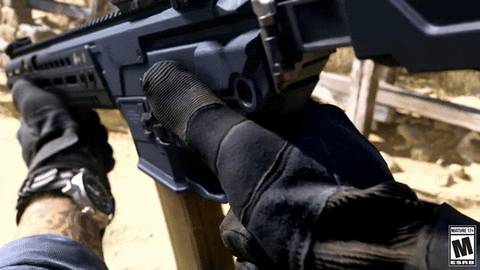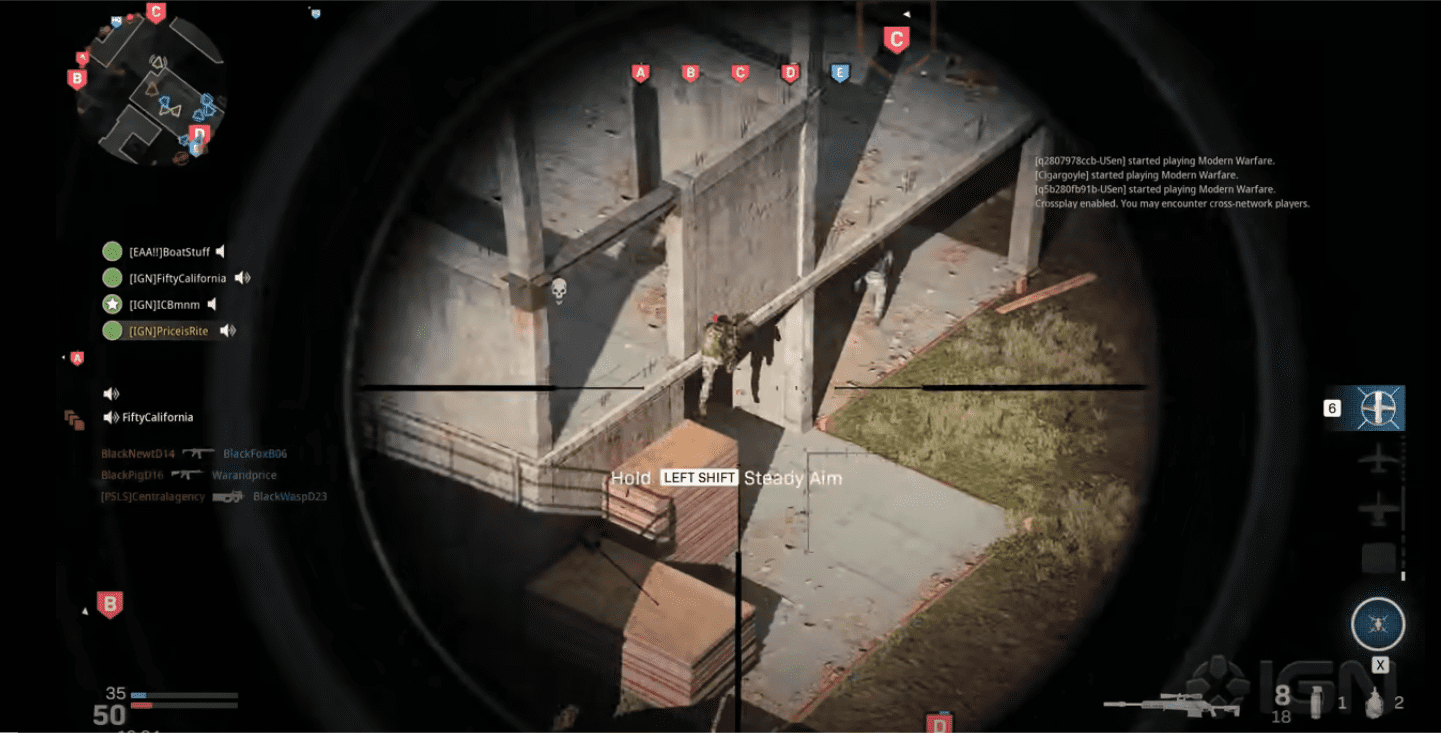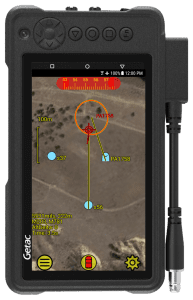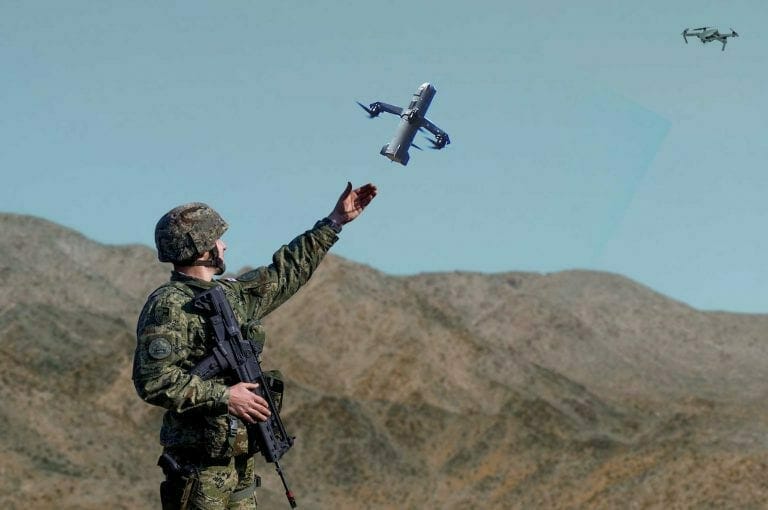If you’ve been paying attention over the last few years, you’ve seen a few nice runs for companies engaged in the security/military space. Patriot One (PAT.C) has done nicely with tech to sniff out security threats at crowded points of access. CAE (CAE.T) is a multi-billion dollar company working in the military sim space. Draganfly (DFLY.C) is gunning hard in the drone space, specifically as it applies to security.
But when you talk to military folks and ask them about the technology that’s in their hands, it invariably comes all the way back to analog systems.
Eye -> Hand -> Gun -> Bullet -> Target.
Which is weird, right? Because if you’re like me, and have been known to play Call of Duty or Halo or Battlefield or Fortnite or ANY FUCKING VIDEO GAME EVER, there are persistent aspects of those games that exist across all of them because, without them, you wouldn’t know where you were going, what you were shooting, or frankly what you were doing.
Here’s a screenshot of some Call of Duty: Modern Warfare gameplay and you’ll see some of what I mean.
Even something as simple as a bullet counter, so you know when you’re running low on ammo, isn’t standard in today’s modern military. Neither is the drone-supplied live map, showing where potential enemy combatants are. And forget about hooking that map up to, say, a mortar, allowing the user to select a target by touching the map. Real time target damage assessments? Maybe in Fortnite, but not in Kandahar.
Your kid gets that stuff. Your soldiers don’t, at least not without having dropped millions of dollars on hardware and hooking into satellites.
But the just publicly-listed Kwesst (KWE.V) is set up to go another way; simple technology upgrades that can be cross-weapon, adaptable to all theaters of conflict, and involve hardware that is a multitude of times less expensive than what’s been traditionally out there.
It runs from the simple, to the exotic, but everything works with everything to make one truly effective integrated network of military efficiency.
Take for example the Kwesst TASCS system.
Kwesst Micro Systems Inc. has completed the first phase of three deliverables under a contract to support a U.S. military customer, featuring the company’s signature Tactical Awareness and Situational Control System (TASCS).
This first deliverable under a $500,000 contract demonstrated the TASCS Integrated Fires Module (IFM) on mortars and the augmented weapon sight (AWS), a system developed by AeroVironment Inc. and Kwesst to provide real-time situational awareness and targeting information. AWS streams full-motion video (FMV) from an overhead unmanned aerial vehicle (UAV) manufactured by AeroVironment into the TASCS architecture for the purposes of target identification, accurate first-shot hits and real-time battle damage assessment (BDA). The AWS system has been a continuing collaboration between Kwesst and AeroVironment.
Seems like that should already exist, but it doesn’t. What you’re seeing in the paragraph above is Kwesst rolling out a real time demo for ‘a military customer’ that, if proven worthwhile, will shift into a much larger supply deal.
And ‘much larger’ in US military terms is LAAAAARGER.
That was two days ago. Today, Kwesst released more news, this time focused on IP.
Kwesst ANNOUNCES PENDING PATENT FOR IMPROVED DIGITAL AIMING SYSTEMS
Kwesst Micro Systems Inc. has confirmed the formalization of patent-pending status of an invention which improves the accuracy of military weapons systems, utilizing a novel micro-optical and computer vision technology, branded Polaris.
Polaris works with digital aiming systems for military weapons including the Kwesst’s flagship tactical and situational control system (TASCS) and its integrated fires module (IFM) to achieve the kind of accuracy normally obtainable only with expensive smart weapons systems. TASCS IFM and its Polaris enhancement comprise an app and simple snap-on device that turns traditional dumb weapons into smart weapons, without any modification to the weapons or ammunition.
If you think Kwesst requires military clients to throw out their existing systems to use the new tech, guess again. The Kwesst folks aren’t knuckleheads.
The TASCS and Polaris suite integrate seamlessly into battlefield management applications (BMA), the software systems used by NATO and NATO allies’ militaries to disseminate information, plan operations, and provide general operational awareness.
The TASCS system plugs right in, folks.
Running low on bullets? Not sure? Hey, don’t pop out your magazine and start counting, instead call Kwesst.
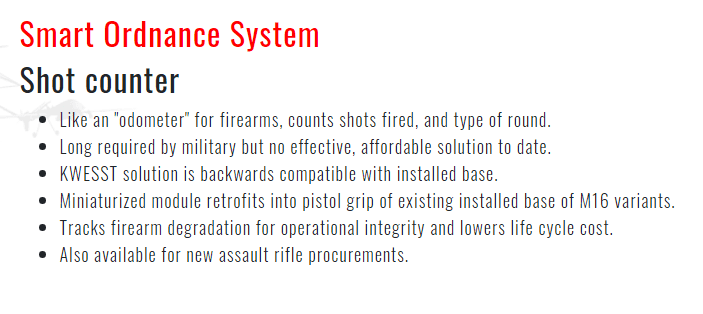 Seems simple because anyone who has played a shoot e’m up game in the last thirty years has had a bullet counter in the corner of their screen, but Kwesst is the first to actually create the tech in a way that’s easily employable in current systems.
Seems simple because anyone who has played a shoot e’m up game in the last thirty years has had a bullet counter in the corner of their screen, but Kwesst is the first to actually create the tech in a way that’s easily employable in current systems.
There’s a distinct tendency in the Kwesst product lineup to split the middle between analog and fully crazy money digital. Take for example their drone system.
Military drones cost millions, so if you bring a drone to a gunfight, you’re risking big money and your tech being co-opted if your drone is taken down by the enemy.
That said – so is the other guy, who has a drone of his own. So what does Kwesst have to counter that?
Why, the counter drone system, of course.
This small, extremely lightweight mini-drone is, effectively, a flying bullet. It holds no charge, no explosive, no chemicals, it’s just a thick flying lump that hones in on enemy drones at up to 350 km/hr, slamming into them and taking them out, using the TASCS system for guidance.
One threat to ground forces that is not often talked about publicly is laser weaponry. There are weapons systems out there, in more despotic parts of the world, that fire lasers across a wide area, looking for optical weapons systems to ruin, and eyeballs to burn out. Gross, right?
So Kwesst has a product that you can mount on a tripod at your perimeter, along with a personal chest-worn version and a 360 degree vehicle mounted version, that spots the laser, locates where it’s coming from, and lets the other Kwesst systems deal with the threat appropriately.
 And hey, all that’s good stuff, but advances in tech can sometimes spill over into the realm of accidental weaknesses. If all your systems are wi-fi connected, your position can be tracked by triangulating your wi-fi signal.
And hey, all that’s good stuff, but advances in tech can sometimes spill over into the realm of accidental weaknesses. If all your systems are wi-fi connected, your position can be tracked by triangulating your wi-fi signal.
Enter the Kwesst electronic decoys, which deflect electromagnetic signatures with false phantom signatures. In essence, if your ‘USMilitaryWifi726’ signal is at point A, Kwesst’s system can shoot multiple copies to different places, and when the enemy comes out to tackle a unit that isn’t actually there – surprise!
Kwesst hasn’t developed all of these assets – some they acquired from other companies in their field that realize the guys behind Kwesst have a better chance of selling their products than the guys that developed them. And some of those competitors understand their products will be a lot more useful when tied into the Kwesst product lineup. This is simple multiplication by addition.
But a lot of this tech HAS been developed by the Kwesst crew because they’re not just a pubco with a roll-up plan, they’re a pubco that has for quite some time been a privateco, with experienced executives that have long established ties to military decision makers. They’re not sketching out ideas on paper that will be developed over the next year and then sold in four years after a two year background check. They’re doing business right now.
They’ve a low low burn rate, a small staff, millions raised sitting in the bank, only 40m shares out which gives them lots of share currency to use to either raise more money or use in an acquisition, and if you wanna go look at their news releases, they’re well written, detailed, and show exactly how every new piece they add works to fit perfectly into the greater puzzle.
But, to me, as good as all of that stuff is, there’s one aspect of this company that I like more than any other… it focuses on the ‘defense’ aspect of the defense industry.
Nothing on the list of tools and tech above will aid in the killing of civilians. Not one part of it.
Yes, in war there’s always the chance innocents will be caught in the crossfire but these tools SPECIFICALLY HELP AVOID THAT SCENARIO.
The entire system is built to protect soldiers, and to help them zero in better on enemy targets, as opposed to just blanket bombing an area and hoping for the best.
- Laser protection? Check.
- Non-explosive drone defense? Check.
- Aiding the proper targeting of weapons systems? Check
- Spoofing wi-fi positions? Check.
There are no guns or missiles or bombs in Kwesst’s product lineup, just protection and targeting assistance. That’s it. I love that because, while sometimes you need to send the soldiers into a situation of last resort, the lives of those being sent in are worth a lot, and so are the lives of people unwittingly drawn into the conflict through no fault of their own.
I’m not a pacifist, I’m a realist. Military is necessary. Security is necessary. But while so much of a military budget is about new ways to kill, finding new ways to survive gets short shrift.
Kwesst is where I want to be.
— Chris Parry
FULL DISCLOSURE: Kwesst is an Equity.Guru marketing client, and we have purchased stock in the company.

